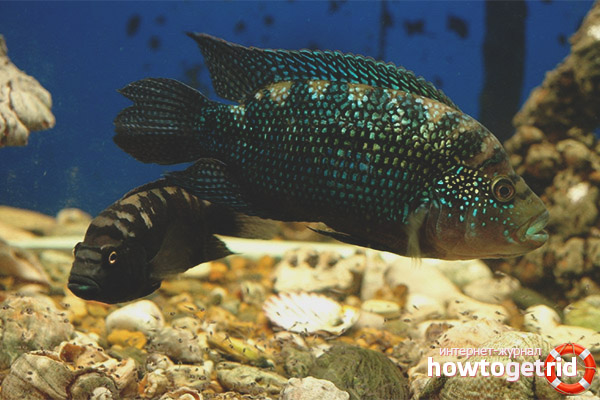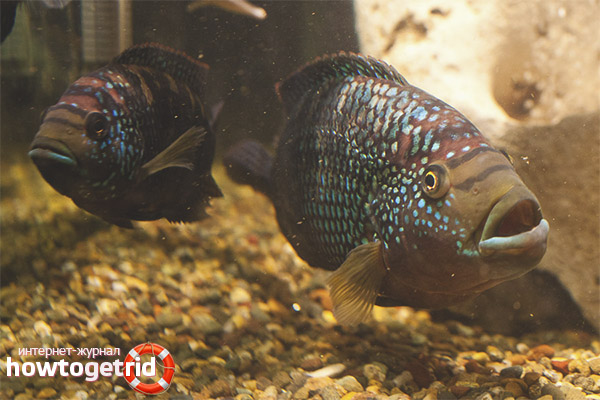The content of the article
Otherwise, the eight-lane cichlazoma is called a bee because of its peculiar color. The fish belongs to large, in length it can reach 25 cm. The body is compact and low. Young individuals are unprepossessing for up to a year, but when they grow up, they become very colorful. Males are more beautiful than females, they are bright and more embossed. Due to the fact that crossbreeding with cichlases is multifaceted, many colors appear. Every fish lover will find an option for himself.
Description
Until 1903, it was not reliably known what eight-lane cichlazomas actually are. They were later described as an independent species.
In terms of habitats, fish prefer to stay in Mexico, Honduras, Guatemala, and Central and North America. They live in lakes, reservoirs, ponds, standing sources or weakly flowing rivers. Float, like all similar species, at the bottom of leafy springs with a large number of snags. Prefer silty or sandy pebble spots.
Diverse food due to the large size of individuals. Small fish, worms and larvae eat cichlazomas.
When an individual reaches puberty, its external data are fully disclosed. Males are famous for their elongated and sharp fins, on which there is a red edging. Females with black stripes and blue spots attract attention.
Young growth can not boast of an impressive color. Such individuals are much duller, grayish with a slight sheen. When the fish is in a stressful situation, its stripes fade, the black tone changes to gray, the scales do not shine.
If you are interested in gender differences, then you should know the following. Males are endowed with hind and dorsal fins with pointed and elongated characteristics. The rim is red, the size of the individual is large, the females are smaller. The males are bright, catchy, stand out from the crowd. The female gender differs from the male in that there are fewer inclusions on the body, and dark spots are noticed on the gills.
Content
- All cichlids, preferably living in the American regions, do not require certain skills in their content. The main thing to consider is the absence of nitrogenous substances in the water. We are talking about nitrates, ammonia, ammonia. The amount of nitrates that do not lead to a deterioration in the health of individuals should not exceed 40 mg / l. To achieve this value, it is necessary to install a water filter taking into account the size of the aquarium and change a third of the new fluid once a week. Since running tap water is harmful and chlorinated in itself, it is best to use filtered or bottled liquids.
- If we take into account the opinion of specialists, young growth can exist in a more polluted environment, but then life expectancy will be reduced. For cichlases, not only the quality of the water, but also the volume of the aquarium is important. In a small aquarium, fish will quickly die. They will also die under constant stress, frequent spawning, poor nutrition.
- It is necessary to ensure the correct temperature regime, it should be 22-30 degrees. When the temperature drops to 24 degrees, individuals will be pressed against the water heater, because they are freezing. Experienced aquarists recommend adhering to indicators of 27 degrees, then cichlomas will become active. The pH balance of water should not go beyond 7-8.5 units.
- For a pair of cichlases, you need a spacious aquarium with a volume of 250 liters.In such conditions, the fish will not tolerate neighborhoods, unless catfish will be among the cohabitants. Also, the striated cichlazomas will become aggressive during spawning, they can beat their brothers to death, despite the fact that they exceed them in size. Be careful, such individuals are best kept separately for safety.
- If you keep fish in an insufficiently spacious aquarium, do not be surprised at skirmishes among the inhabitants. In addition, often quarrels are carried out between opposite sexes. Often, females provoke conflicts. Moreover, they are not even afraid that they are less in weight category. It happens that males do not take this seriously. In this case, more mobile females give a real thrashing. If the male is angry and there will be a real duel, the opponent will not be bored. If you notice this behavior, transplant the female into another aquarium, otherwise she will die during a skirmish.
- If you keep individuals in an aquarium with a volume of less than 300 liters. Fish of the opposite sex should be regularly isolated from each other. The normal mode of keeping individuals is considered to be from 3 to 6 months. After this, the joint stay of fish is recommended to be interrupted for 1-2 months. If the aquarium is large enough, then there is no need to separate the individuals. In the event of a quarrel, the female can swim to the other end of the tank without any problems. In this case, the male will not pursue her. Also isolating the pair can be useful in another case. The bottom line is that in this way you can reduce the frequency of spawning. Frequent throwing of caviar negatively affects the health of the female.
- Alternatively, cichlase can be contained in a harem. There will be several females per male. Such content will benefit everyone. The male will be able to take care of the females in turn without any problems. If you grow males together, then as they grow up, as a rule, they will not show aggression towards each other. In rare cases, skirmishes may occur. In most cases, it all depends on the nature of the individuals.
- It is worth considering the fact that in more spacious aquariums, cichlasomas behave quite peacefully. As for small containers, individuals in them often exhibit aggression. Therefore, in large aquariums you can contain cichlids of various types. Breeders, on the contrary, say that the content of different species negatively affects the general condition of eight-lane cichlases. An exception occurs only when all the young growth grows together. It is not recommended to contain representatives of the species in question with small fish. Otherwise, sooner or later small individuals will be eaten.
- As for aquarium plants, cichlomas do not eat them. The only thing worth noting is that fish sometimes uproot vegetation. Cichlazomas simply may not like where the algae grows. It is recommended to plant hard-leaved plants in separate containers. Also, various shelters must be present in the aquarium.
There is nothing complicated in the content of the presented subspecies of aquatic inhabitants. Cihlazomas do not require special conditions of detention, it is enough to provide them with high-quality filtered water with an optimal pH balance and temperature regime under which the fish will not freeze. It is worth paying attention to the neighborhood, because cichlazomas are aggressive towards strangers.
Video: cichlazoma eight-lane











Submit